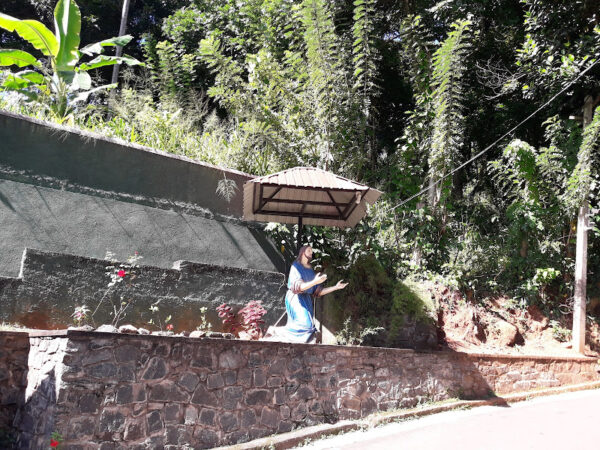“Monte Fano” – Benedictine Monastery in Kandyan Hills
By Arundathie Abeysinghe
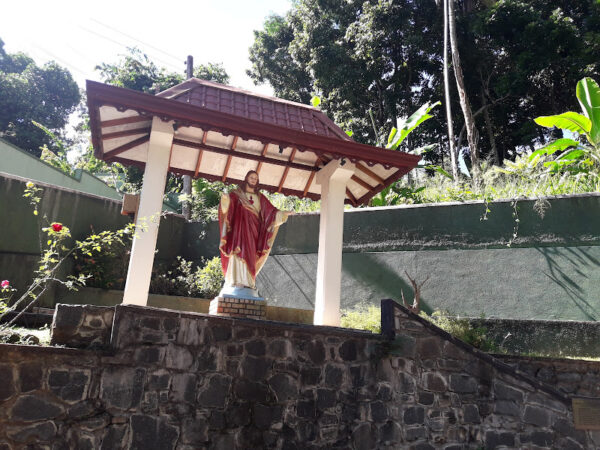
 Situated in a tranquil location away from the hustle and bustle of Kandy City amidst cool climes of Ampitiya, Monte Fano is the mother house of the Sylvestro – Bendictine monks in Sri Lanka. Monte Fano stands in impeccable harmony with its environs, simple, yet majestic, lending magnetism to the landscape, a vast rectangular building depicting archetypal colonial architecture. Its remote location and salubrious climate provide seclusion and peace necessary for prayer as well as study. Family spirit forms the very core of the Benedictine life, according to *St. Benedict’s concept of a monastery, a spiritual family where the Abbot is the father and the monks are brethren of Christ.
Situated in a tranquil location away from the hustle and bustle of Kandy City amidst cool climes of Ampitiya, Monte Fano is the mother house of the Sylvestro – Bendictine monks in Sri Lanka. Monte Fano stands in impeccable harmony with its environs, simple, yet majestic, lending magnetism to the landscape, a vast rectangular building depicting archetypal colonial architecture. Its remote location and salubrious climate provide seclusion and peace necessary for prayer as well as study. Family spirit forms the very core of the Benedictine life, according to *St. Benedict’s concept of a monastery, a spiritual family where the Abbot is the father and the monks are brethren of Christ.
Monte Fano has an exact carbon copy of the *Shroud of Turin.
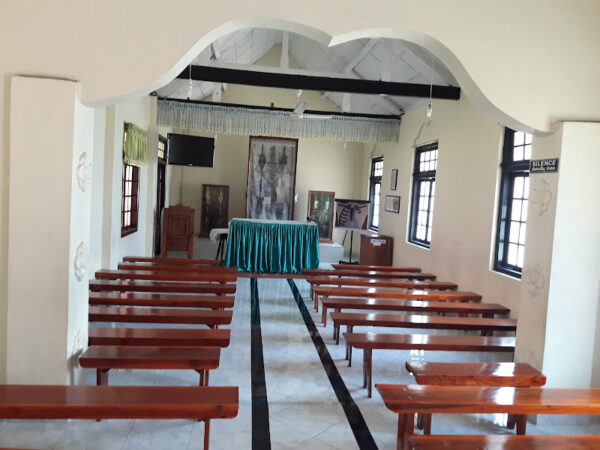
The work of Sylvestro – Benedictine monks is well-explained as: “Per Crucem Ad Lucem” (in Latin meaning through the cross to the light). “What we are is God’s gift to us and what we become is our gift to God”.
“Benedictus amabat montes” (Benedict loved the mountains) is an old saying about St. Benedict. Deliberately, Fr. Bonfilius Galassi OSB and Hildebrand Van Reyk OSB (Prior during that period and Master of Novices respectively) would have followed this motto when they selected a hillock in the salubrious spectacular suburbs of Kandy as the appropriate site for the headquarters of the Benedictine Monks of Sri Lanka.
According to Library records at Monte Fano, Sylvestro – Benedictine monks had built a beautiful *Abbey in Kandy in 1874 with permission from Rome, named it St. Anthony’s Monastery and the first batch of novices had been taken in for religious transformation. In 1875, under the leadership of Abbot Rev. Fr. Leo Cingolani OSB, the Monastery had been uplifted to an Abbey. Rev. Fr. Bede Beekmeyer became the first Sri Lankan Benedictine monk to be consecrated as Bishop of Kandy. In November 1927, the monks had purchased Yatawara Walauwa, an isolated *Walauwa (belonging to Loku Bandara Yatawara Dissawe) situated on a hillock to set up the headquarters of the Benedictine Monastery, restructured the building and converted it into a monastery naming it “Monte Fano”.
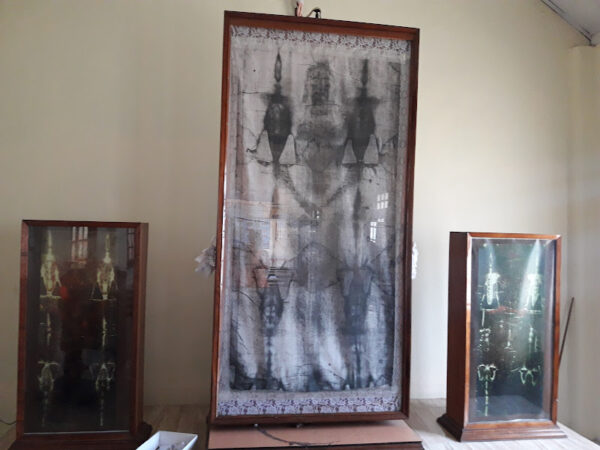
The House had been blessed on November 25, 1927 by the Prior Major. On the following day, (November 26, 1927) the feast of the Founder, Fr. Hildebrand Van Reyk had been celebrated and the Holy Mass had been held bringing into being “Monte Fano”, a haven for the sons of St. Sylvester. Thereafter, constructions commenced at Monte Fano with regular shifts of the Chapel, refectory and the parlour. The new chapel was blessed by Bishop Regno, the incumbent Bishop of Kandy, a son of St. Sylvester. Monte Fano was named after the “Mother House” in Italy.
The Monastery Chapel is an appropriate tribute to the ingenuity and creativity of Very Rev. Dom Romuald Baldarelli, the erstwhile Superior Major of Monte Fano. Built according to alluring archetypical Kandyan design, it harmonizes with the environment perfectly.
Meanwhile, in May 1983, be decree of the General Chapter which was held in Rome, Monte Fano received a new identity and was named a Conventual Priory of St. Sylvester, Abbot. Hence, on February, 9th 1989, a new Retreat Centre was declared opened at Monte Fano to comply with those who sought a Benedictine environment.
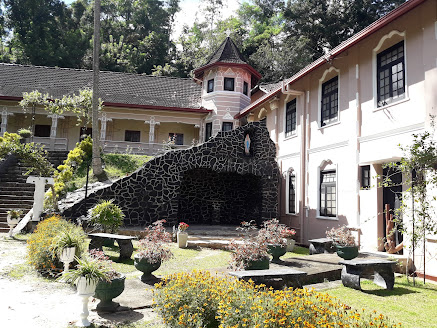
The monks consider the Monastery, their home on earth, a genuinely fraternal spirit, leaving their homesteads as well as their possessions to follow Christ, a life of dedicated service…
The wall on the long aisle that leads to the office of the Conventual friar has black and white photos of former Abbots who had served faithfully. The monks take the vows of obedience, poverty, chastity, conversion of manners as well as stability.
The Postulants learn catechism and church history at Monte Fano. Thereafter, they are sent to the Novitiate in *Adisham Monastery in Haputale.
Monte Fano is a powerhouse of prayer for those who seek the companionship of God.
Monte Fano recently concluded the 175th anniversary (jubilee) celebrations of its presence and mission in Sri Lanka.
Fr. Shamindra Jayawardena OSB is the present Conventual Prior at Monte Fano, Ampitiya, Kandy, the youngest friar in the history of Sri Lankan Benedictine monks.
Special thanks to Fr. Shamindra Jayawardena OSB, Conventual Prior at Monte Fano for his valuable insights for the article.
- Abbey – During medieval times, an Abbey was a place of rest where weary travelers had found refuge. Hence, travelers would ring the doorbell, assuming a monk would take them in, in spring, summer or winter. Similarly, during the vintage era of Ceylon, an Abbey had existed in the mountains of the magnificent citadel of Kandy. Gradually, the Abbey and Abbot (chief monk) have faded away, instead a religious monastery had been constructed on a hillock in Kandy.
- Ceylon – Sri Lanka gained Independence from British Colonials in 1948. In 1972, Ceylon became a republic within the Commonwealth and was thereafter known as Sri Lanka.
- Mudaliyar – Also known as Mudali was a colonial title and office in *Ceylon, an official position of the native headman system. During the Portuguese Colonial Era, the title of Mudaliyar was created by Portuguese colonials in the 17th century by enlisting natives. During the British Colonial Era, locals from wealthy influential families who were loyal to the British Crown were appointed and the appointments were non-transferable.
- Shroud of Turin – The Shroud of Turin is a 14-foot (approximately 4.2 meters) linen cloth bearing an image of a crucified person which has become a popular Catholic icon. Approximately, 600 years after it first appeared in historical records, the Shroud of Turin is considered as a significant religious symbol of Christians globally.
- Benedict – Saint Benedict of Nursia or Norcia (c. 480 CE – c. 547) was the founder of the Benedictine Monastery at Monte Cassino and the father of Western monasticism (the Rule he established became the norm for monastic living throughout Europe). In 1964, in view of the work of monks following the Benedictine Rule in the evangelization and civilization of the majority of countries in Europe in the Middle Ages, Pope Paul VI proclaimed him the patron saint of Europe.
- Walauwwa – Derived from the Tamil word “valavu” signifies a large house with a compound or garden with aristocratic implications. According to Sinhala social stratum, the pinnacle of walauwwas is the “wasala walauwwa” (wasala, derived from vaasal meaning an entrance in Tamil). According to Sinhalese social hierarchy, a wasala walawwa is usually the ancestral residence of a *mudaliyar.
Distance from Kandy – 4.1 kilometers (approximately 20 minutes)
Directions: The Monastery can be reached after traveling on Ampitiya – Talatuoya Road and turning right (after traveling about four kilometers) along a winding road, the façade of Monte Fano gradually comes into view with a cross on the rooftop.
As Monte Fano is a monastery, it is necessary to maintain its serene edifying atmosphere and divine peace when visiting it…
- Adisham Bungalow – wrapped in serenity of misty hills – By Arundathie Abeysinghe
